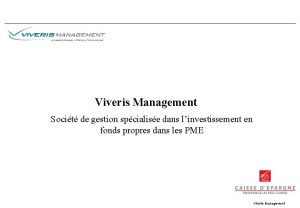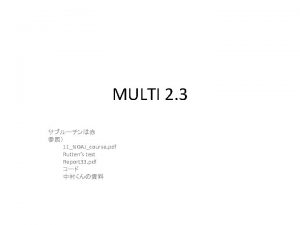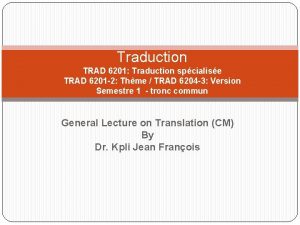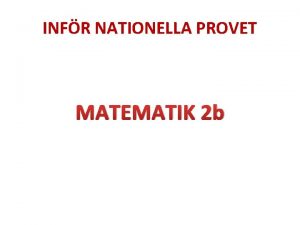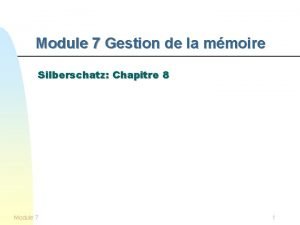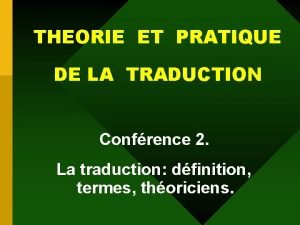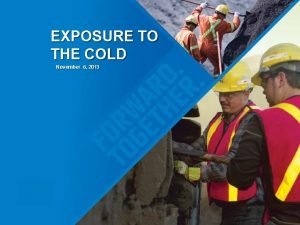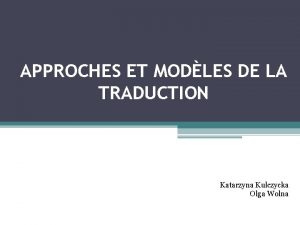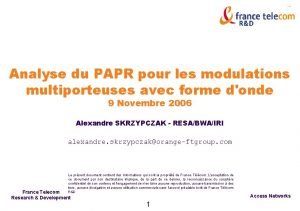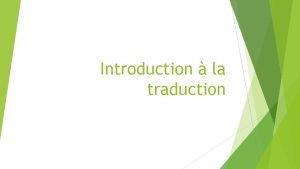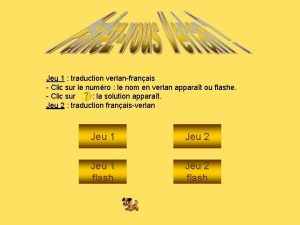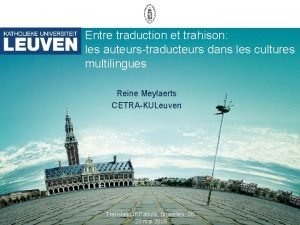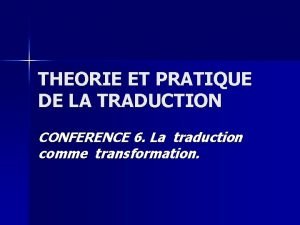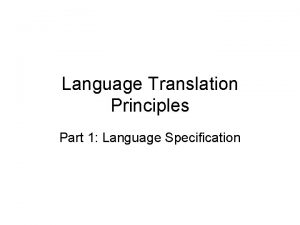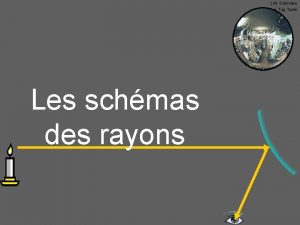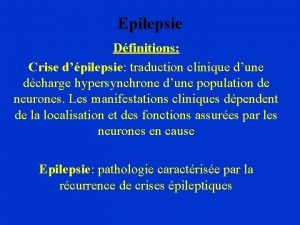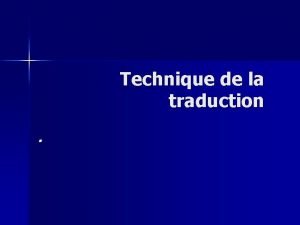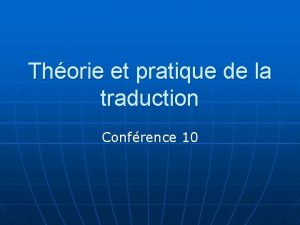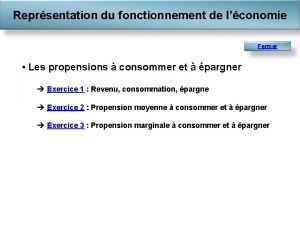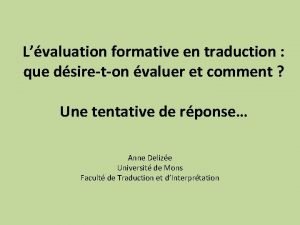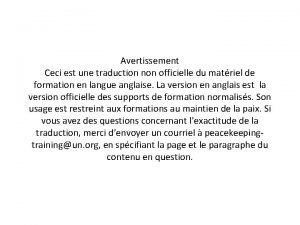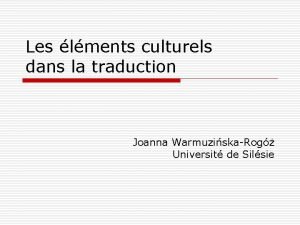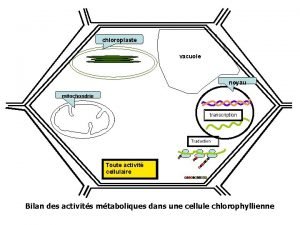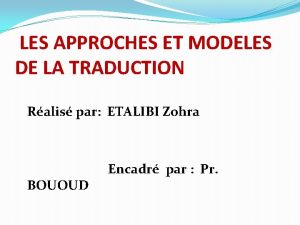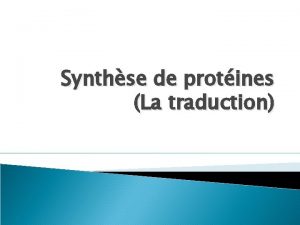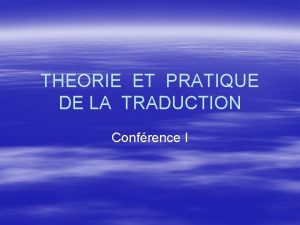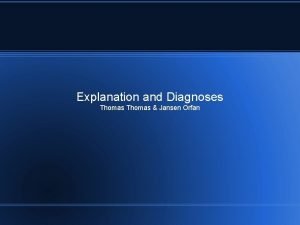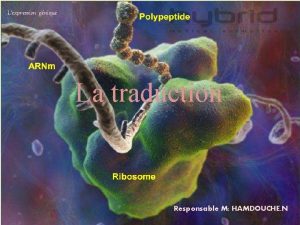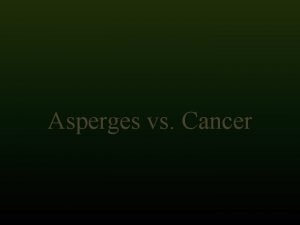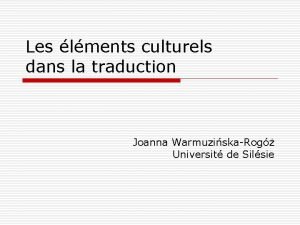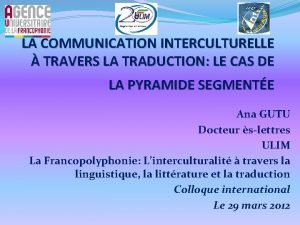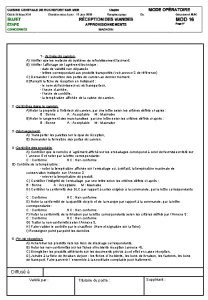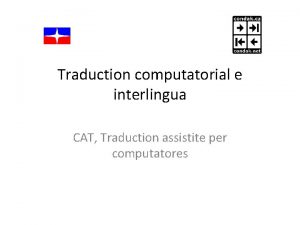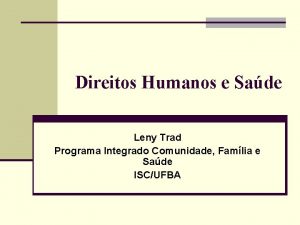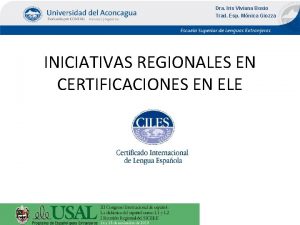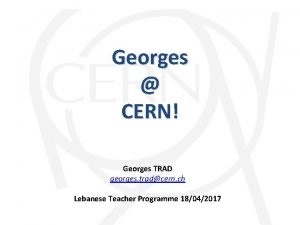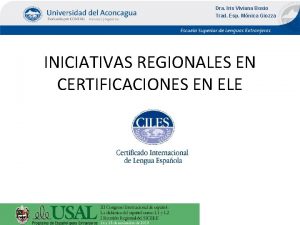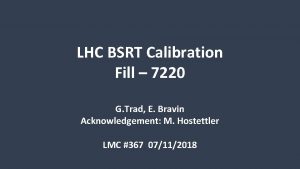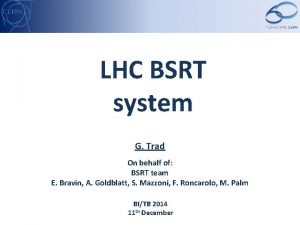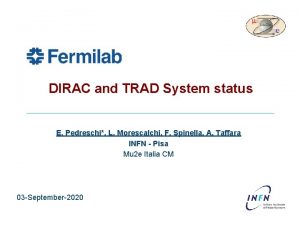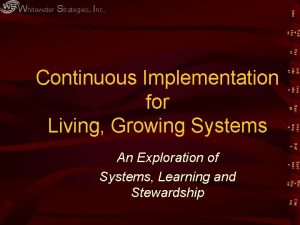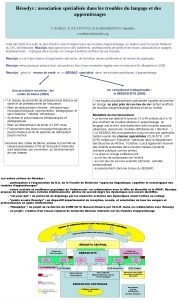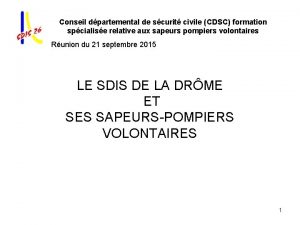Traduction TRAD 6201 Traduction spcialise TRAD 6201 2







![CONTEXTUALIZATION How to find a good translation of [dark whisper] ? Ø By looking CONTEXTUALIZATION How to find a good translation of [dark whisper] ? Ø By looking](https://slidetodoc.com/presentation_image_h2/50e9ee760e2427f7e30a5c3e72bc7535/image-8.jpg)




































































- Slides: 76

Traduction TRAD 6201: Traduction spécialisée TRAD 6201 -2: Thème / TRAD 6204 -3: Version Semestre 1 - tronc commun General Lecture on Translation (CM) By Dr. Kpli Jean François

ADVANCED TRANSLATION OPERATIONS q Objectives �Present some advanced translation operations �Present documentary search issues �Present miscellaneous translation issues

Overview of the Linguistic Pyramid: Discourse translation issues and operations �A this level Sentences combine to form a discourse, a text, a document DISCOURSE LEVEL Sentences D Sentences SENTENCE LEVEL Words Phrases S Phrases Words WORD LEVEL Morphemes W Morphemes

ADVANCED TRANSLATION OPERATIONS § Contextualization § Transposition § Crossover /chassé-croisé § Use of crossover to transcode result prone structures § Modulation § Expansion, reinforcement/étoffement

CONTEXTUALIZATION This translation operation consists in looking in the context for clues that help detect the meaning of words or expressions. The context could be the immediate environment of the word or the overall text.

CONTEXTUALIZATION Consider the word: Dark in the following text: There should have been a dark whisper in the wind. Or maybe a deed chill in the bone. Something. An ethereal song only Elisabeth or I could hear. A tightness in the air. Some textbook premonition. There are misfortunes we almost expect in life – what happened to my parents, for example – and then there are other dark moments, moments of sudden violence, that alter everything. There was my life before the tragedy. There is my life now. The two have painfully little in common.

CONTEXTUALIZATION The French equivalence of Dark is Noir: Dark Noir [the meaning given by the dictionary] But added to Whisper: Dark whisper murmure noir [murmure noir] is certainly not a good translation
![CONTEXTUALIZATION How to find a good translation of dark whisper Ø By looking CONTEXTUALIZATION How to find a good translation of [dark whisper] ? Ø By looking](https://slidetodoc.com/presentation_image_h2/50e9ee760e2427f7e30a5c3e72bc7535/image-8.jpg)
CONTEXTUALIZATION How to find a good translation of [dark whisper] ? Ø By looking for clues in the context. Clues: What do these elements suggest ? 1. deed chill in the bone, 2. tightness in the air, misfortunes what happened to my parents 3. 4. 5. 6. other dark moments Tragedy Painfully

CONTEXTUALIZATION They seem to suggest : Death What is the adjective in French for Death when added to murmure ? Mumure de mort ? [un mort ne peut murmurer] -- Mumure …………

CONTEXTUALIZATION � Example of Transalation from French to English � Translation of Titles. AFFAIRE SOCIETE D’OR AKAZA SA CONTRE DAME KOFFI -------------------------------------DOSSIER N° 1 PRODUIT EN DEFENSE DES INTERETS DE LA SOCIETE D’OR AKAZA SA AU DOSSIER DE LA PREMIERE CHAMBRE DU TRIBUNAL DE COMMERCE D’ABIDJAN

CONTEXTUALIZATION Procedure: To translate « AFFAIRE » 1. Consider the field: Here: Justice, Court, Tribunal 2. Consider the CONTENT of the document. Read what follows. QUESTION: IS TRANSLATING « AFFAIRE » by « CASE » enough ?

CONTEXTUALIZATION �Certainly not. �Hence the two items procedure (1 &2) Case at court or Court Case

TRANSPOSITION q Transposition is certainly the most frequently used procedure in translation. Il can be compulsory due to restrictions of the TL , but it is also used for aesthetics and register purposes. Often students focus on their text and are not aware that they are not obliged to translate a verb with a verb, a noun with a noun, an adverb with an adverb… Note: Keep in mind that English tends to favor verbal expressions and French nominal expressions

TRANSPOSITION(Con’t) q Transposition When we move from SL to TL, transposition is the act of changing the grammatical category without changing the meaning of the sentence. The following examples are true for both English to French translation and French to English translation. v Verb Noun As soon as the sun rises…: dès le lever du soleil… Society is to blame: C’est la faute de la société It will cost you £ 200 to have the car repaired: La réparation de la voiture vous coûtera 200 livres They hid in the barn to avoid being slaughtered: Ils se sont cachés dans la grange afin d’échapper au massacre

TRANSPOSITION(Con’t) q Transposition v Modal Adverb Dogs can be dangerous: Les chiens sont parfois dangereux He may have missed the train: Il a peut-être manqué le train She must have forgotten to come: Elle a sûrement/sans doute oublié de venir v Adverb Verb He almost missed his plane: Il a failli manquer son avion They eventually arrived at 7: Ils ont fini par arriver à 7 heures He only/simply/merely/just added that…: Il s’est contenté d’ajouter que The situation is still worrying: la situation demeure/reste préoccupante He will soon realize she does not love him: Il ne tardera pas à se rendre compte qu’elle ne l’aime pas.

TRANSPOSITION(Con’t) q Transposition v Adverb Noun Reckless drivers are often treated too leniently: les conducteurs imprudents sont souvent traités avec trop d’indulgence. She shamelessly took advantage of the situation: elle a abusé de la situation sans vergogne. v Adverb Adjective “Don’t do that again!” she said threateningly: « ne refais plus cela! » dit-elle menaçante “Why don’t you listen to me? ” he asked discontentely: « Pourquoi ne m’écoutez-vous pas ? » demanda-t-il mécontent.

TRANSPOSITION(Con’t) q Transposition v Adjective Noun/prepositional phrase unspoken lies: Mensonges par omission……. It was unprofessional of him: Il a fait preuve d’un manque de professionnalisme v How + Adj Noun He does not realize how serious the situation is: il ne se rend pas compte de la gravité de la situation

TRANSPOSITION(Con’t) q Transposition Exercise: translate these sentences based on the examples provided above: The Prime Minister successfully handled the crisis ØShe was trying to forget how disappointed she was not to see him. ØShe was aware of how important her decision was. Ø I might ask him to come. Ø

TRANSPOSITION(Con’t) q Transposition Correction of the exercise: Ø The Prime Minister successfully handled the crisis Le Premier Ministre a réussi à résoudre la crise (Adv – verb) Ø She was trying to forget how disappointed she was not to see him: Elle essaie d’oublier sa déception de ne pas l’avoir vu (How+adj - noun) Ø She was aware of how important her decision was: elle était consciente de l’importance de sa décision (How+adj - noun) Ø I might ask him to come. Je lui demanderai éventuellement de venir (modal – Adv)

CROSSOVER /CHASSÉ-CROISÉ q Crossover /chassé-croisé This is a translation operation used to translate a sentence like: He ran into the room: il est entré dans la pièce en courant « ran » indicates the way of moving and “into” the direction English describes first the “process of moving” before the result of that process. French does exactly the contrary. It describes the result first by expressing the direction taken before indicating the way the result is made. English Process Result

CROSSOVER /CHASSÉCROISÉ(Con’t) q Crossover /chassé-croisé This is why we start the translation into French with the second part of the sentence instead of starting at the beginning. Ø He tiptoed into the lounge: Il est entré dans le salon sur la pointe des pieds Ø They sailed around the world: ils ont fait le tour du monde à la voile Ø He elbowed his way through the crowd: il s’est frayé un chemin à travers la foule en jouant des coudes Ø The train roared into the station: le train est entré dans la gare avec un bruit fracassant

CROSSOVER /CHASSÉCROISÉ(Con’t) q Crossover /chassé-croisé The same operation can be used to translate an adverb group + adjective. The English adjective is then translated with a noun and the English adverb with an adjective Ø It is unbearably hot: il fait une chaleur insupportable Ø He was unacceptably rude: il a été d’une grossièreté inadmissible

CROSSOVER /CHASSÉCROISÉ(Con’t) Use of crossover to transcode result prone structures q In some cases the Verb of the sentence expresses an action and the various units on its right indicate the result of that action Subject + Verb + (Group = Adj. , Adv. , or Prep. + Group) Eg. He kicked the door open S Action Result Use of a crossover operation to translate by starting at the end: Result Action : Il a ouvert la porte d’un coup

CROSSOVER /CHASSÉCROISÉ(Con’t) Examples of use of crossover to transcode result prone structures : Ø He ate himself sick: Il s’est rendu malade à force de manger Ø He was knifed to death in the street: Il a été tué à coup de couteau dans la rue Ø His parents shamed him into working: Ses parents ont réussi à le faire travailler en lui faisant honte Ø You won’t manage to drink your problems away:

CROSSOVER /CHASSÉCROISÉ(Con’t) Exercise on Crossover/chassé-croisé Translate these sentences based on the examples provided above: ØHe crept down to the kitchen ØHe often reads himself to sleep ØThe players were booed and hissed off the field ØThe city has changed beyond all recognition

CROSSOVER /CHASSÉCROISÉ(Con’t) Exercise on Crossover/chassé-croisé (con’t) ØShe hurried past me Ø It is unseasonably cold ØThey cycled up the hill ØHe flew to England

CROSSOVER /CHASSÉCROISÉ(Con’t) Correction of the exercise on crossover: Ø He crept down to the kitchen: Il est descendu jusqu’à la cuisine à pas de loup Ø He often reads himself to sleep: il s’endort souvent en lisant Ø The players were booed and hissed off the field: les joueurs ont quitté le terrain sous les hués et sous les sifflets Ø The city has changed beyond all recognition: la ville est méconnaissable tant elle a changé

CROSSOVER /CHASSÉCROISÉ(Con’t) Correction of the exercise on crossover: Ø She hurried past me: elle est passée à côté de moi précipitamment Ø It is unseasonably cold: il fait un froid anormal pour la saison Ø They cycled up the hill: ils ont monté la côte à bicyclette Ø He flew to England: il est allé en Angleterre en avion

MODULATION q Modulation is a change of viewpoint that allows to express differently the same phenomenon. The reality is the same. Eg. in French : une bouteille à moitié pleine or une bouteille à moitié vide There are lexical modulations and syntactic modulations. Lexical modulations are often compulsory. Syntactic modulations are optional but help suggest more elegant translations

MODULATION(Con’t) v. Lexical Modulation (often called equivalences). They are often fixed expressions or idioms. The translator has only to find the equivalence in TL using the same lexical field

MODULATION(Con’t) �Examples of lexical modulations Ø A part whole He was walking on tiptoe. il marchait sur la pointe des pieds He is peeping through the keyhole. Il regarde par le trou de la serrure Ø A part Another part It costs an arm and a leg Cela coûte les yeux de la tête

MODULATION(Con’t) ØTranslation of a few idioms French § A bird in the hand is worth two in the bush Un tiens vaut mieux que deux tu l’auras § Birds of a feather flock together Qui se ressemble s’assemble § The early bird catches the worm

MODULATION(Con’t) • Ex. of Syntactic modulations Ø Translation by using the negative contrary § Remember to buy the paper N’oublie pas d’acheter le journal § He kept talking during the lesson Il n’arrêtait pas de parler pendant le cours

MODULATION(Con’t) Translation by reversal of the terms (same technique as the crossover/ chassé-croisé) Ø § They own the flat L’appartement leur appartient § They were waiting in the cold, teeth chattering Ils attendaient dans le froid en claquant des dents

MODULATION(Con’t)) ØArticle « a » Article « le/la » Cas des parties du corps (possession inaliénable) § I must wash my hands Il faut que je me lave les mains § He wouldn’t lift a finger to help me Il ne lèverait pas le petit doigt pour m’aider

MODULATION(Con’t) Exercise on Modulation Translate the following utterances using modulation § Be all skin and bones/She slammed the door § § § in his face As fat as a pig/Charity begins at home A friend in need is a friend indeed She has a guilty conscience Coffee keeps me awake Whether he will run for president is anyone’s guess I have a headache and a sore throat

MODULATION(Con’t) Correction of the exercise on Modulation § Be all skin and bones: N’avoir os que la peau et les She slammed the door in his face: Elle lui a claqué la porte au nez § As fat as a pig: Gros comme une barrique § A friend in need is a friend indeed C’est dans la malheur qu’on reconnaît les vrais amis § She has a guilty conscience: Elle n’a pas la conscience tranquille § Coffee keeps me awake: Le café m’empêche de dormir § Whether he will run for president is anyone’s guess Personne ne sait s’il va se présenter à la présidence

HOME WORK �Find equivalences for the following expressions: 1. Be as alike as two peas in a pod 2. The spitting image of someone 3. Like father, like son 4. Great minds think alike 5. Look like a drowned rate 6. Cut a fine figure 7. Be stone deaf 8. Fall on deaf ears 9. Go bananas

CORRECTION OF THE HOMEWORK 1. 2. 3. 4. 5. 6. 7. 8. 9. Be as alike as two peas in a pod/se ressembler comme d’eau goutes d’eau The spitting image of someone/ le portrait craché de qqn Like father, like son/ tel père, tel fils Great minds think alike/ les grands esprits se rejoignent Look like a drowned rat/être trempé jusqu’aux os Cut a fine figure/avoir fière allure Be stone deaf/ être sourd comme un pot Fall on deaf ears/ tomber dans les oreilles d’un sourd Go bananas / devenir dingue/piquer une crise

EXPANSION, REINFORCEMENT/ ÉTOFFEMENT q Expansion, reinforcement/ étoffement Generally English is more concise than French. Therefore in lots of cases we must explain the translation of one word by using several words in TL because one word in the TL will not be enough. That expansion operation is used to transcode prepositions, conjuncts, etc. in

EXPANSION, REINFORCEMENT/ ÉTOFFEMENT(Con’t) v Expansion of prepositions Ø With a Noun § He asked after you: Il a demandé de tes nouvelles § A deed chill in the bone : un froid à vous glacer les os § What is the price from London ? Quel est le prix au départ de Londres § It is a major advance in genetics: C’est une avancée considérable en matière de génétique

EXPANSION, REINFORCEMENT/ ÉTOFFEMENT (Con’t) Ø With a Verb § He is dying for a cigarette: Il meurt d’envie de fumer une cigarette § She asked for you: Elle a demandé à te voir/à te parler § He went to the supermarket for cheese, ham and eggs : Il est allé au supermarché pour acheter du fromage, du jambon et des œufs

EXPANSION, REINFORCEMENT/ ÉTOFFEMENT (Con’t) Exercise: Translate the following using the expansion operation: 1. Everybody on me 2. Put the champagne on me 3. She can’t sleep for the pain 4. He helped her with the children 5. It depends on when she will arrive 6. The problem of how to recycle nuclear waste comes up regularly

EXPANSION, REINFORCEMENT/ ÉTOFFEMENT (Con’t) Correction of the exercise on expansion 1. Everybody on me ! Tout le monde, suivez-moi ! 2. Put the champagne on me Mettez le champagne sur mon compte 3. She can’t sleep for the pain La douleur l’empêchait de dormir 4. He helped her with the children Il l’a aidé à s’occuper des enfants 5. It depends on when she will arrive Cela dépend du moment où elle arrivera 6. The problem of how to recycle nuclear waste comes up regularly Le problème du recyclage des déchets nucléaires se pose régulièrement

PROFESSIONAL TRANSLATION ISSUES �Course General Objective q Train Learners on Professional translation issues � Specific Objectives Overview of the Linguistic Pyramid for discourse level issues § Present an advanced level translation operation § How to determine text type and do documentary search § Miscellaneous translation issues §

Overview of the Linguistic Pyramid for discourse level issues Refer to the Pyramid slide N° 3

An advanced level translation operation CONTEXTUALIZATION Refer to slide N° 9

How to determine text type & do documentary search How to determine text type, field of knowledge and do documentary search Ø This is done in Step 2 of the translation procedure. To be able to fully understand a text we must determine its specificity and the translation difficulties involved. Looking up words in a dictionary is not enough, we must also make a documentary search on the specific field. q

How to determine text type & do documentary search. CH Ø Documentary search The text contains words and expressions that give indications on the field and sub-fields of knowledge v Find them v Look for documents and read them to have an idea on the kind of terminology used

How to determine text type & do documentary search Example 1: « Dans les essais sur les populations en disjonction F 3 à F 5, 540 populations ont été cultivées avec les deux systèmes de gestion décrits au Tableau 7. Les parcelles principales mesuraient 0, 5 x 5 m (deux rangées de 5 m de long), sans répétition. Les variétés témoins (IAC 164, IDSA 6 et WAB 56 -104) étaient répétées toutes les 20 entrées testées. Le semis a été fait en poquets avec un espace de 25 x 25 cm et une densité de deux semences/touffe, et l’on a sélectionné les plants individuels exhibant des caractères désirables. À la récolte, l’on a enregistré le nombre de jours jusqu’à maturité, la hauteur de plant et les dégâts des maladies et des insectes sur tous les plants sélectionnés. »

How to determine text type & do documentary search �Although the words: Populations, densité, maturité, maladies Suggest that the test refer to human beings, the whole text has nothing to do with human beings On the contrary words like : Parcelles, variétés, semis, semence, touffe, plants, récolte Suggest agriculture. In addition words like semence, semis, determine a more specific field within the broad field of agriculture, what is it ? Clue: Find what IDSA is………

How to determine text type & do documentary search Translation: « In the trials on segregating F 3 -F 5 populations, 540 populations were grown under the two management levels described in Table 7. Primary plots were 0. 5 x 5 m (two rows, 5 m long), with no replication. The check varieties (IAC 164, IDSA 6 and WAB 56 -104) were replicated after every 20 test entries. The seeds were dibbed at a spacing of 25 x 25 cm, with two seeds/hill, and individual plants with desirable characteristics were selected. At harvesting, observations were made of days-to-maturity, plant height and disease and insect pest damage on all selected plants. »

How to determine text type & do documentary search Exemple 2 “Deforestation also contributes to the release of CO 2, as forests absorb and therefore contain huge quantities of carbon, which is released when trees are burned or otherwise destroyed. However, there is currently no consensus on the amount of CO 2 released. The presence of greenhouse gases in the atmosphere means that heat from the sun gets trapped in the Earth’s atmosphere. In other words, the Earth absorbs more heat that it is able to dissipate. Although this phenomenon is natural, it is now out of control, producing what is called global warming. ” The words underlined suggest the field of pollution and subsequently climate change as indicated by global warming

How to determine text type & do documentary search Example 3: Tuberculosis control is a policy priority in Russia Tuberculosis suggests the field of health: La lutte contre la tuberculose est une priorité de la politique de santé de la Russie

MISCELLANEOUS TRANSLATION ISSUES SUBJECT RULE In French, sometimes the subject of the verb of a subordinate clause is implied, there should be coreference with the subject of the main clause. (Meertens 2011: 45) EX. Les processus intellectuels qui vont de pair avec la traduction sont trop complexes pour les analyser Since the subject is implied, le subject of Analyser is suspected to be « processus » , which is inadequate. The « processus » cannot analyse themselves. What should

MISCELLANEOUS TRANSLATION ISSUES �Use: « pour que l’homme puisse » or « pour qu’il soit possible de » « Les processus intellectuels qui vont de pair avec la traduction sont trop complexes pour qu’il soit possible de les analyser » Les processus intellectuels qui vont de pair avec la traduction sont trop complexes pour qu’il soit possible [à un être humain] de les analyser

MISCELLANEOUS TRANSLATION ISSUES � « Base » and « basé » Avoid SUR LA BASE DE in the translation into French Use: selon, à partir de, en se fondant sur, sur la foi de, à la lumière de, en fonction de, au vu de, sur le modèle de, à raison de, au titre de, en vertu de, etc.

MISCELLANEOUS TRANSLATION ISSUES « On the basis of information gathered through in-depth study, the administrative services were completely reorganized » -- [Sur la base] À partir d’informations recueillies [dans le cadre de] au cours d’une étude approfondie, les services administratifs ont été entièrement réorganisés

END OF SESSION THANK YOU !

DISCOURSE LEVEL TRANSLATION ISSUES q How to translate passive sentences The passive is more frequently used in English than in French The English verb does not need to be transitive to be in the passive. It is followed by its preposition in the passive as well as in the active voice. Ex. The doctor was sent for : On envoya cher le docteur The Bed had not been slept in: Le lit n’avait pas été défait Since French does not favor the passive, it has many resources to translate the English

DISCOURSE LEVEL TRANSLATION ISSUES v Use of “on” Time can be conceived as the intervals during which events occur On peut définir le temps comme une succession d’intervalles durant lesquels des événements se produisent v Restructuring, the agent becomes the subject of the active sentence Sleepers are disturbed by nightmares: les cauchemars troublent le sommeil des dormeurs

DISCOURSE LEVEL TRANSLATION ISSUES v Use of an Impersonal verb To make one pound of aluminum, approximately 7 k. Wh are needed, an amount of electricity that would supply an average household for several hours: Pour produire une livre d’aluminium, il faut près de 7 k. Wh, soit une quantité d’électricité suffisante pour combler les besoins d’une famille moyenne pendant plusieurs heures. v Nominalization of the verb How your husband is regarded is something important: La réputation de votre mari est une chose importante

DISCOURSE LEVEL TRANSLATION ISSUES q How to make a text coherent and cohesive Coherence is used to refer to the consistency in the organization of information. It relates to meaning whereas Cohesion has to do with how the structure of the text is harmoniously woven Ex. Halliday’s model: In the organization of sentences, a clause contains two segments. The first segment if called the THEME (what the clause is about) and the RHEME is what the speaker says about the Theme.

DISCOURSE LEVEL TRANSLATION ISSUES v Functions of the THEME 1. It acts like a point of orientation by connecting back to previous stretches of discourse thereby maintaining a coherent point of view 2. It acts as a point of departure by connecting forward and contributing to the development of later stretches Ex. Ptolemy’s model provided a reasonably accurate system for predicting the positions of heavenly bodies in the sky

DISCOURSE LEVEL TRANSLATION ISSUES v Functions of the RHEME It represents the very information that the speaker wants to convey to the hearer. It fulfills the communicative purpose of the utterance Ex. Ptolemy’s model provided a reasonably accurate system for predicting the positions of heavenly bodies in the sky The RHEME is : provided a reasonably accurate system for predicting the positions of heavenly bodies in the sky The positioning in the structure of the THEME and the RHEME maintains the coherence of the message and therefore of the whole text

DISCOURSE LEVEL TRANSLATION ISSUES Ex. Aristotle thought that the earth was stationary and that the sun, the moon, the planets, and the stars moved in circular orbits about the earth T 1 Aristotle thought that T 2 the earth R 1 R 2 was stationary (and that) T 3 the sun, the moon, the planets and the stars R 3 moved in circular orbits about the earth

DISCOURSE LEVEL TRANSLATION ISSUES When the THEME and RHEME positioning is not consistent, the text may be grammatically correct but not acceptable. Ex. Now comes the President here. It’s the window he is stepping to wave to the crowd. On his victory his opponent congratulates him. “Gentlemen and Ladies”. That you are confident in me honours me. q Cohesion is the surface relation that connects together words and expressions Ex Mrs Thather has resigned. She announced her

Thank you

The Translation Procedure q. A 9 -Step Procedure q The Timing of the Process

A 9 -Step Procedure q Step 1: What is the main point of the text? General meaning, register type etc. q Step 2: Do a lexical search. Look up all the words you don't recognize or know the meaning of. Use a monolingual dictionary for words you don’t recognize, then check them in the bilingual one when you are satisfied q Step 3: Make a personal glossary of specialized terms (specially when there is a change that they may be repeated in the text)

A 9 -Step Procedure q Step 4: text Create a first draft translation of the on a word processor § Make sure that you do not translate the word level, § If you translate sentence by sentence remember that you must check later that the sentences flow naturally together in the TL. § Now put the original text to one side and just read your translation as a piece of writing in its own right. It should read naturally q Step 5: Check the translation against the original to make sure that you have included all details accurately q Step 6: Leave the translation aside (for 48 hours)

A 9 -Step Procedure q Step 7: Revise the translation without referring to the source text and Produce a second draft (this is known as stylistic revision or editing) q Step 8: Produce a final draft. To do this you will need to repeat steps 5 to 8. Along the way, you may notice some things that had escaped you before, in which case you might need to revisit some of the earlier steps too (for example, steps 3 and 4).

General advice on the procedure If you do find yourself constantly going back to the first steps, then there is something wrong - possibly with your understanding of the text’s contents and/ or purposes. q You need to be honest in your assessments of your own capabilities, and perhaps do more work on your source language comprehension for example. q If you keep using the procedure, and adapting it to your own needs, a few years down the track it will be so ingrained and automatic that people who are just beginning might wonder how you can do things so q

The Timing Process Time is the essence ! Learn to pace yourself, after (approx. ) 250 word, check your watch q First 15 minutes: read through the text, following step 1 (what is the point, the field, the register? ). Start working with your dictionaries and in mind on steps 2&3 (Make a lexical search, look how to solve terminological problems). But remember: you cannot write at this stage! q Next hour: steps 4 & 5: Write the first draft. Do it on PC if you can q Next 30 to 45 minutes: Steps 6 to 8: Check it against the original. Then, once these minutes have gone, stop right there! So, how far did you get? q

The Timing Process q If you keep following the steps and timing yourself, at the end of the semester, at the end of the course, q Your chances of succeeding will have improved. q But you must adapt these processes to your own needs. q Don’t stop using them, even when you’ve become accredited and are out there in the profession.

Using Online-Computer Translation Prog.
 Baseline exemple
Baseline exemple Spcialise
Spcialise Viveris management
Viveris management Trad
Trad Trad
Trad Trad
Trad Trad theory
Trad theory étoffement traduction
étoffement traduction Trad
Trad En tråd som är 48 cm lång böjs till en rektangel
En tråd som är 48 cm lång böjs till en rektangel När blommar körsbärsträden i japan
När blommar körsbärsträden i japan Microbes
Microbes Waladi traduction
Waladi traduction Critres
Critres Je regrette l'europe aux anciens parapets signification
Je regrette l'europe aux anciens parapets signification Traduction
Traduction Module 7 à table
Module 7 à table L traduction
L traduction La théorie du jeu en traduction
La théorie du jeu en traduction Maitrise traduction ulaval
Maitrise traduction ulaval Frostnip traduction
Frostnip traduction Schlucht traduction
Schlucht traduction Traduction
Traduction Traduction
Traduction Wbridge5
Wbridge5 Traduction
Traduction Introduction sur la traduction
Introduction sur la traduction Traduction
Traduction Pocha traduction
Pocha traduction Pascal meyns
Pascal meyns Traduction
Traduction Traduction
Traduction L traduction
L traduction Language translator
Language translator Traduction
Traduction Citron traduction
Citron traduction Epilepsie traduction
Epilepsie traduction Senior citizen traduction
Senior citizen traduction Traduction
Traduction Traduction question
Traduction question Traduction
Traduction Vertical traduction
Vertical traduction Traduction take care rihanna
Traduction take care rihanna Traduction
Traduction Traduction
Traduction Traduction non officielle
Traduction non officielle Traduction
Traduction Traduction
Traduction Minx traduction
Minx traduction Traduction
Traduction Il-kantilena
Il-kantilena Vertical traduction
Vertical traduction Sociologie de la traduction
Sociologie de la traduction Traduction
Traduction Senior citizen traduction
Senior citizen traduction Traduction
Traduction Traduction
Traduction Thomas jansen abs
Thomas jansen abs Traduction
Traduction Traduction
Traduction Asperge et cancer
Asperge et cancer Corvidol
Corvidol Traduction
Traduction Traduction abducted
Traduction abducted Traduction
Traduction


